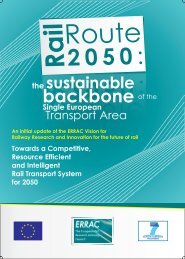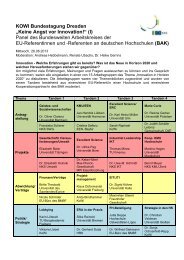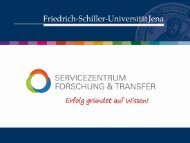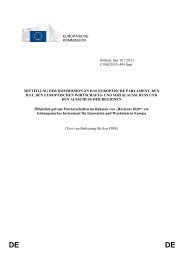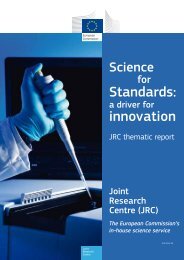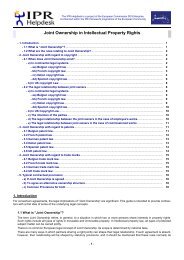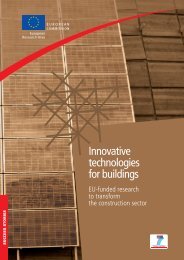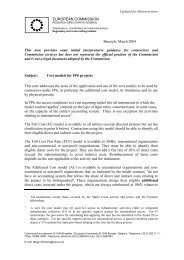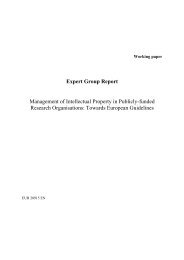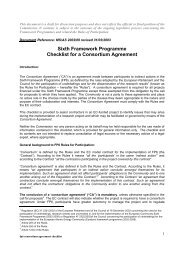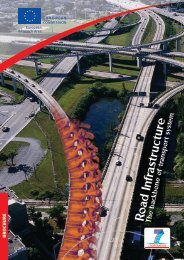Guide to Financial Issues relating to FP7 Indirect Actions - KoWi
Guide to Financial Issues relating to FP7 Indirect Actions - KoWi
Guide to Financial Issues relating to FP7 Indirect Actions - KoWi
Create successful ePaper yourself
Turn your PDF publications into a flip-book with our unique Google optimized e-Paper software.
sums are deemed <strong>to</strong> be undertaking only research and technological activities in the<br />
project.<br />
For a legal entity established in an ICPC, if the lump sum option is chosen, the<br />
contribution in a project is based on the amounts in Table 1. These amounts must be<br />
multiplied by the <strong>to</strong>tal number of person-years for the project requested by the ICPC legal<br />
entity. When the person is not working full-time on the project, these amounts must be<br />
reduced <strong>to</strong> take in<strong>to</strong> account the portion of his/her working time devoted <strong>to</strong> the project.<br />
The maximum EU/Eura<strong>to</strong>m contribution is calculated by applying the upper funding<br />
limits in Table 2 <strong>to</strong> the resulting amount. This amount is all inclusive, covering support<br />
<strong>to</strong>wards both the direct and the indirect costs. In other words, the lump sum is deemed <strong>to</strong><br />
cover all costs of a participant from an ICPC country, including not only the costs of<br />
personnel and travel, but also, among others, equipment, consumables, subcontracts and<br />
indirect costs.<br />
Example: SME from ICPC country (low-income) having chosen a lump-sum, in a 3-year collaborative<br />
project GA with 6 researchers working on the project full-time and 3 working part-time at 50%<br />
Total researcher-years for the project: 3 years x 7.5 researchers/year= 22.5<br />
Funding for the SME: 22.5 researcher/year x EUR 8,000 /year= EUR 180,000 x 0,75 (75% reimbursement<br />
rate for an SME in a collaborative project)= EUR 135,000<br />
Article 33 (6) of the Rules for participation provides for the application of upper funding limits <strong>to</strong> the lumpsums<br />
amounts. For simplification purposes, for funding schemes with research and technological<br />
development activities, participant's option for the use of lump-sums are deemed <strong>to</strong> be undertaking only<br />
research and technological activities in the project.<br />
2.2 Payment of lump-sums for ICPC beneficiaries<br />
The payment of the pre-financing for the lump-sums follows the same rules as the<br />
standard pre-financing (usually 160% of the average EU funding per reporting period).<br />
The interim payments following a reporting period will also follow the general rules and<br />
will be made on the basis of Form C (financial statement) and the actual time worked by<br />
the ICPC beneficiary during the period in question. For the final payment, the same rules<br />
apply (including the approval of the final report by the Commission)<br />
The contribution for the ICPC participants is agreed as part of the budget during the<br />
negotiations, based on the lump sums approved by the Commission. Their work is defined<br />
in Annex 1 <strong>to</strong>gether with the work of the other participants. Payments will be made based<br />
on actual effort involved. Payments are released based on periodic reporting (as for the<br />
other beneficiaries) but ICPC beneficiaries only have <strong>to</strong> report on the time devoted <strong>to</strong> the<br />
project and not on the costs incurred.<br />
2.3 Reporting and auditing of lump-sums for ICPC beneficiaries:<br />
As the lump-sums are calculated on the basis of researchers/year, the reports submitted by<br />
the ICPC beneficiary will include the financial Form C and the number of actual hours<br />
worked by the researchers on the project. Consequently, the beneficiary will keep a record<br />
of the time (e.g. timesheets) worked by the researchers on the project The Commission<br />
services and the other entities authorised by the ECGA may carry out audits on the<br />
premises of the beneficiary <strong>to</strong> verify its compliance with this requirement<br />
As the beneficiaries are paid on the basis of lump-sums, there is no requirement <strong>to</strong> submit<br />
certificates on financial statements, even if the EU/Eura<strong>to</strong>m contribution is above the<br />
threshold of EUR 375,000.<br />
90



